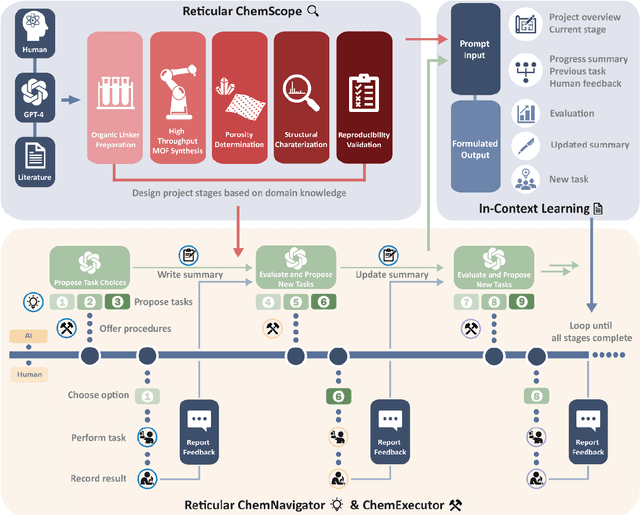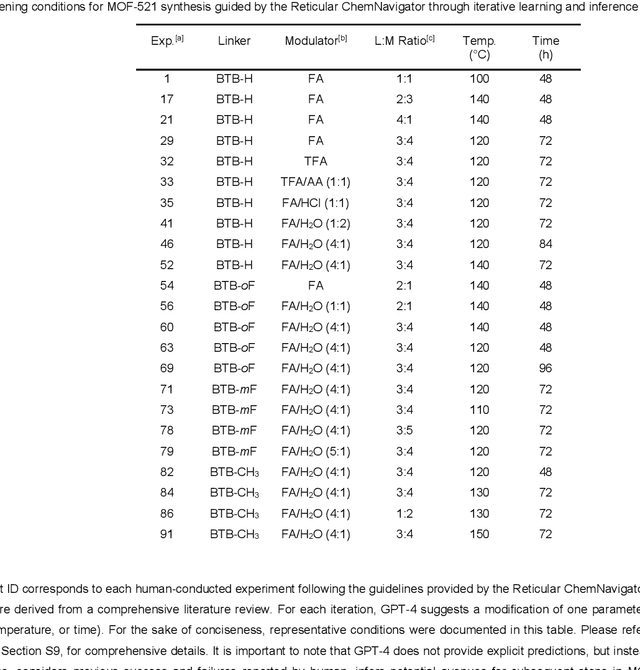Jennifer T. Chayes
Single and Multi-Hop Question-Answering Datasets for Reticular Chemistry with GPT-4-Turbo
May 03, 2024Abstract:The rapid advancement in artificial intelligence and natural language processing has led to the development of large-scale datasets aimed at benchmarking the performance of machine learning models. Herein, we introduce 'RetChemQA,' a comprehensive benchmark dataset designed to evaluate the capabilities of such models in the domain of reticular chemistry. This dataset includes both single-hop and multi-hop question-answer pairs, encompassing approximately 45,000 Q&As for each type. The questions have been extracted from an extensive corpus of literature containing about 2,530 research papers from publishers including NAS, ACS, RSC, Elsevier, and Nature Publishing Group, among others. The dataset has been generated using OpenAI's GPT-4 Turbo, a cutting-edge model known for its exceptional language understanding and generation capabilities. In addition to the Q&A dataset, we also release a dataset of synthesis conditions extracted from the corpus of literature used in this study. The aim of RetChemQA is to provide a robust platform for the development and evaluation of advanced machine learning algorithms, particularly for the reticular chemistry community. The dataset is structured to reflect the complexities and nuances of real-world scientific discourse, thereby enabling nuanced performance assessments across a variety of tasks. The dataset is available at the following link: https://github.com/nakulrampal/RetChemQA
Image and Data Mining in Reticular Chemistry Using GPT-4V
Dec 09, 2023Abstract:The integration of artificial intelligence into scientific research has reached a new pinnacle with GPT-4V, a large language model featuring enhanced vision capabilities, accessible through ChatGPT or an API. This study demonstrates the remarkable ability of GPT-4V to navigate and obtain complex data for metal-organic frameworks, especially from graphical sources. Our approach involved an automated process of converting 346 scholarly articles into 6240 images, which represents a benchmark dataset in this task, followed by deploying GPT-4V to categorize and analyze these images using natural language prompts. This methodology enabled GPT-4V to accurately identify and interpret key plots integral to MOF characterization, such as nitrogen isotherms, PXRD patterns, and TGA curves, among others, with accuracy and recall above 93%. The model's proficiency in extracting critical information from these plots not only underscores its capability in data mining but also highlights its potential in aiding the creation of comprehensive digital databases for reticular chemistry. In addition, the extracted nitrogen isotherm data from the selected literature allowed for a comparison between theoretical and experimental porosity values for over 200 compounds, highlighting certain discrepancies and underscoring the importance of integrating computational and experimental data. This work highlights the potential of AI in accelerating scientific discovery and innovation, bridging the gap between computational tools and experimental research, and paving the way for more efficient, inclusive, and comprehensive scientific inquiry.
ChatGPT Chemistry Assistant for Text Mining and Prediction of MOF Synthesis
Jun 20, 2023Abstract:We use prompt engineering to guide ChatGPT in the automation of text mining of metal-organic frameworks (MOFs) synthesis conditions from diverse formats and styles of the scientific literature. This effectively mitigates ChatGPT's tendency to hallucinate information -- an issue that previously made the use of Large Language Models (LLMs) in scientific fields challenging. Our approach involves the development of a workflow implementing three different processes for text mining, programmed by ChatGPT itself. All of them enable parsing, searching, filtering, classification, summarization, and data unification with different tradeoffs between labor, speed, and accuracy. We deploy this system to extract 26,257 distinct synthesis parameters pertaining to approximately 800 MOFs sourced from peer-reviewed research articles. This process incorporates our ChemPrompt Engineering strategy to instruct ChatGPT in text mining, resulting in impressive precision, recall, and F1 scores of 90-99%. Furthermore, with the dataset built by text mining, we constructed a machine-learning model with over 86% accuracy in predicting MOF experimental crystallization outcomes and preliminarily identifying important factors in MOF crystallization. We also developed a reliable data-grounded MOF chatbot to answer questions on chemical reactions and synthesis procedures. Given that the process of using ChatGPT reliably mines and tabulates diverse MOF synthesis information in a unified format, while using only narrative language requiring no coding expertise, we anticipate that our ChatGPT Chemistry Assistant will be very useful across various other chemistry sub-disciplines.
GPT-4 Reticular Chemist for MOF Discovery
Jun 20, 2023



Abstract:We present a new framework integrating the AI model GPT-4 into the iterative process of reticular chemistry experimentation, leveraging a cooperative workflow of interaction between AI and a human apprentice. This GPT-4 Reticular Chemist is an integrated system composed of three phases. Each of these utilizes GPT-4 in various capacities, wherein GPT-4 provides detailed instructions for chemical experimentation and the apprentice provides feedback on the experimental outcomes, including both success and failures, for the in-text learning of AI in the next iteration. This iterative human-AI interaction enabled GPT-4 to learn from the outcomes, much like an experienced chemist, by a prompt-learning strategy. Importantly, the system is based on natural language for both development and operation, eliminating the need for coding skills, and thus, make it accessible to all chemists. Our GPT-4 Reticular Chemist demonstrated the discovery of an isoreticular series of metal-organic frameworks (MOFs), each of which was made using distinct synthesis strategies and optimal conditions. This workflow presents a potential for broader applications in scientific research by harnessing the capability of large language models like GPT-4 to enhance the feasibility and efficiency of research activities.
 Add to Chrome
Add to Chrome Add to Firefox
Add to Firefox Add to Edge
Add to Edge